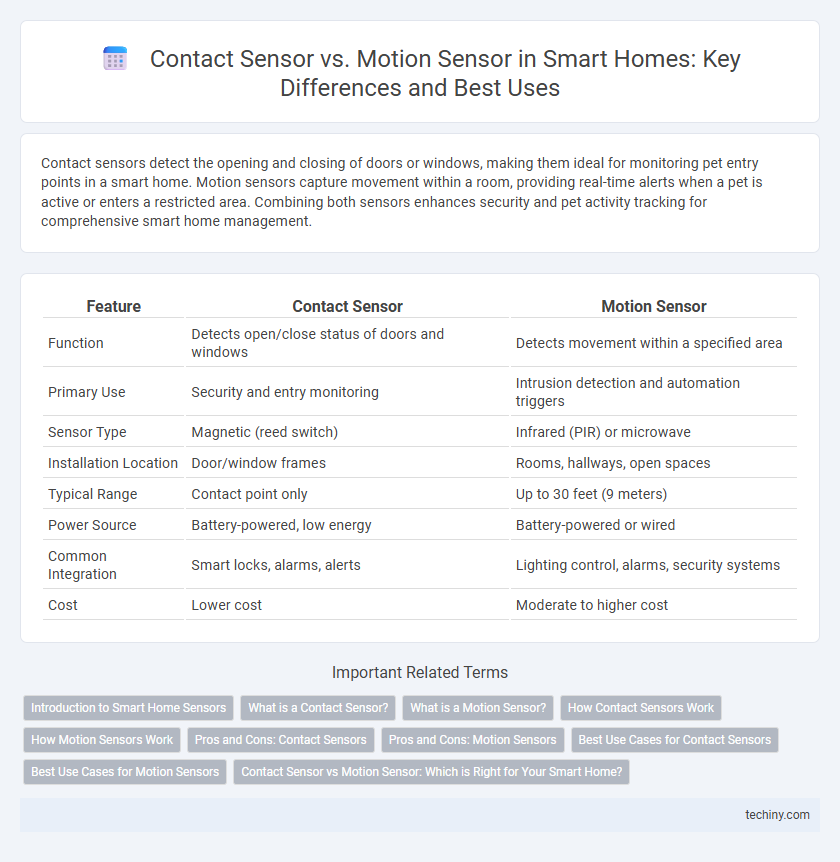Contact sensors detect the opening and closing of doors or windows, making them ideal for monitoring pet entry points in a smart home. Motion sensors capture movement within a room, providing real-time alerts when a pet is active or enters a restricted area. Combining both sensors enhances security and pet activity tracking for comprehensive smart home management.
Table of Comparison
| Feature | Contact Sensor | Motion Sensor |
|---|---|---|
| Function | Detects open/close status of doors and windows | Detects movement within a specified area |
| Primary Use | Security and entry monitoring | Intrusion detection and automation triggers |
| Sensor Type | Magnetic (reed switch) | Infrared (PIR) or microwave |
| Installation Location | Door/window frames | Rooms, hallways, open spaces |
| Typical Range | Contact point only | Up to 30 feet (9 meters) |
| Power Source | Battery-powered, low energy | Battery-powered or wired |
| Common Integration | Smart locks, alarms, alerts | Lighting control, alarms, security systems |
| Cost | Lower cost | Moderate to higher cost |
Introduction to Smart Home Sensors
Contact sensors detect the opening and closing of doors or windows, providing real-time alerts for security and automation in smart homes. Motion sensors identify movement within a defined area, enabling features like occupancy detection and energy-efficient lighting control. Both sensors play critical roles in enhancing home security and automation by monitoring environmental changes and occupant activity.
What is a Contact Sensor?
A contact sensor is a smart home device designed to detect the opening or closing of doors, windows, or cabinets by monitoring the physical contact between two components. It typically consists of a magnet and a sensor that triggers alerts when the magnetic connection is broken, enhancing home security and automation. Contact sensors integrate seamlessly with smart home systems to provide real-time notifications and enable automated responses like turning on lights or activating alarms.
What is a Motion Sensor?
A motion sensor detects movement within a specific area using technologies like infrared, ultrasonic, or microwave signals, triggering alerts or automations in smart home systems. Unlike contact sensors that monitor the open or closed status of doors and windows, motion sensors actively track presence and activity to enhance security and energy efficiency. These sensors play a crucial role in automating lighting, alarms, and climate control by sensing human motion in real time.
How Contact Sensors Work
Contact sensors detect the opening or closing of doors and windows by monitoring the separation between two magnetic components. When the magnetic connection is broken, the sensor sends a signal to the smart home system, triggering alerts or automations. These sensors enhance security by providing real-time updates on entry points, improving safety and energy management.
How Motion Sensors Work
Motion sensors detect movement by using technologies such as passive infrared (PIR) to sense changes in heat or ultrasonic waves to detect sound reflections within a defined area. These sensors convert physical motion into electrical signals, triggering alerts or activating connected devices within a smart home system. Their effectiveness in monitoring occupancy and enhancing security relies on rapid detection and accurate differentiation between human movement and environmental noise.
Pros and Cons: Contact Sensors
Contact sensors provide reliable monitoring by detecting the opening and closing of doors or windows, making them essential for security in smart homes. They consume minimal power and offer straightforward installation, but their limitation lies in only detecting contact state changes without tracking movement within a space. Compared to motion sensors, contact sensors are less suited for comprehensive intrusion detection but excel in perimeter security and energy-saving automation.
Pros and Cons: Motion Sensors
Motion sensors in smart homes provide enhanced security by detecting movement and triggering alerts or automations, making them ideal for monitoring large areas. They may sometimes generate false alarms due to pets or environmental changes, which can reduce reliability. Power consumption tends to be moderate, depending on the technology, balancing between battery life and responsiveness.
Best Use Cases for Contact Sensors
Contact sensors excel in monitoring the open or closed status of doors and windows, providing critical alerts for security and energy efficiency. They are ideal for detecting unauthorized entry points and automating lighting or HVAC systems based on door or window activity. These sensors are best suited for perimeter security and access control in smart home environments.
Best Use Cases for Motion Sensors
Motion sensors excel in detecting movement within a space, making them ideal for security monitoring and automatic lighting control in hallways, entryways, and outdoor areas. They are perfect for activating alarms when unauthorized motion is detected or for energy savings by turning lights on and off based on room occupancy. Unlike contact sensors that monitor door or window status, motion sensors provide real-time presence detection, enhancing overall smart home automation and safety.
Contact Sensor vs Motion Sensor: Which is Right for Your Smart Home?
Contact sensors detect the opening and closing of doors or windows, providing precise alerts for entry points, while motion sensors monitor movement within a room to trigger lighting or security systems. Contact sensors are ideal for monitoring access and ensuring perimeter security, whereas motion sensors enhance indoor automation and intruder detection. Choosing between the two depends on your smart home's specific security needs and automation goals.
Contact Sensor vs Motion Sensor Infographic

 techiny.com
techiny.com